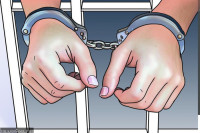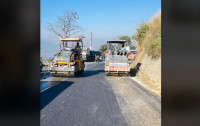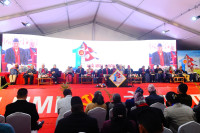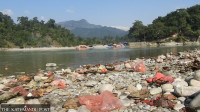National
Republic Memorial unclear on what and who it commemorates
To the east of the Narayanhiti Palace, in the heart of Kathmandu, lies a park sprawling over 35 ropanis. There are gardens and stone-paved walkways, along with a giant elliptical structure with four pedestals, one in each cardinal direction. But there are no people in the park, as its gates have never opened to the public.
Bibhu Luitel
To the east of the Narayanhiti Palace, in the heart of Kathmandu, lies a park sprawling over 35 ropanis. There are gardens and stone-paved walkways, along with a giant elliptical structure with four pedestals, one in each cardinal direction. But there are no people in the park, as its gates have never opened to the public.
Construction of the Ganatantra Smarak, or Republic Memorial, began in March 2012. Despite the fanfare it received from then-prime minister Baburam Bhattarai, the park has been a muddled memorial, unclear on what and who it is commemorating.
The Home Ministry, which is charged with deciding who to commemorate, has yet to decide whose stories will be displayed on the memorial.
“We have yet to be informed about which war or movement the individual pedestals of the memorial will be dedicated to,” said Macha Kaji Maharjan, senior division engineer at the Department of Urban Development and Building Construction.
Since the very beginning, the imagining of the memorial has been controversial and confused, according to a 2014 academic paper analysing the rhetoric surrounding the design competition. The paper, ‘The Politics of Memory: Designing the Ganatantra Smarak’, by Bryony Whitmarsh of the University of Oxford, states: “The constant re-positioning and adjustment of the design reveals a level of political ambivalence towards the notion of transitional justice and demonstrates confusion over the construction of a new national identity, for example, tensions between modernist notions of a unified nation-state and the reality of an ethnically diverse nation.”
There were plans to open the memorial to the public in 2016 since all construction had been completed, but the failure to decide on the various people’s movements and the role they would play in memorialisation led to the delays, said Maharjan.
This ambitious memorial park also includes a hall that is supposed to have a gallery space with photographs of the various movements, but the hall, too, is empty as the photographs have yet to be decided. Throughout the world, the commemoration of past wars and conflicts—and the manner in which they are remembered—has long been contentious.
One memorial widely celebrated as sensitive and thought-provoking is the ‘Memorial to the murdered Jews of Europe’ in the German capital of Berlin. The construction of this memorial was completed in just 20 months and was open to the public two days after completion. This is what Nepal’s Department of Urban Development and Building Construction should learn from, said Maharjan. “The whole process of construction is slow in our context because we do not agree on a common concept,” he said.
There are officers in the ministry itself who oppose the primary intention behind the entire project, said one Home Ministry official who wished to remain anonymous.
“Some officers want it to be known as the martyrs’ park and commemorate martyrs from all the movements that took place in Nepal,” they said.
There is further confusion about whether or not to remember those who were handicapped during the various movements for democracy and republicanism. “Some people lost their limbs while others only received minor injuries. We are not sure if we should be remembering the latter,” said the official.
The memorialisation of those who made significant contributions to Nepal’s arduous struggle for full democracy and republican rights is not a new practice. From the Sahid Smarak Park in Hetauda to Sahid Gate in Kathmandu, there are a number of public memorials to individuals throughout the country.
The Republic Memorial too is another attempt at a collective memorialisation of the more recent 2006 People’s Movement. There are no plans to commemorate the 10-year civil conflict or the 2007 Madhes Movement, which made immense contributions to ushering in federal republicanism in Nepal.
The working through of moments of civil conflict in societies and the process of memorialisation—broadly termed as the politics of memory—can often serve as opportunities for reconciliation and healing. For instance, Rwanda remembers the genocide of 1994 with the Kigali Genocide Memorial, which was inaugurated in 2004. The Memorial functions in tandem with the Peace Education programme for people born after the genocide, where Rwanda’s Ministry of Education keeps history alive and educates the younger generation about one of the biggest mass slaughters in the history of mankind.
In Whitmarsh’s paper, presented at the Social Science Baha in 2016, Nepal’s politics of memory does not aim to do what Germany and Rwanda have done. In fact, it tends to go the opposite way, towards the “physical framing of a unified national identity that did not and does not exist.”
Discussing a site that is meant to keep alive the memory of past events, Whitmarsh concludes, “The politicians who are defining this public history would appear to agree that the best way to put the recent past behind is not to dwell on it too much.”
Sushant Bhattarai, 24, from Gairidhara, passes the memorial park every day on his way to work in Thamel but he is unaware of what it signifies. “It has been there for years now,” said Bhattarai. “But I’m not aware of its purpose.” The park, he said, never shows any signs of humans whenever he passes.
The Ganatantra Smarak is slated to open to the public on May 28, Republic Day.




 15.12°C Kathmandu
15.12°C Kathmandu















